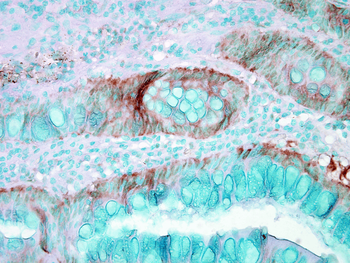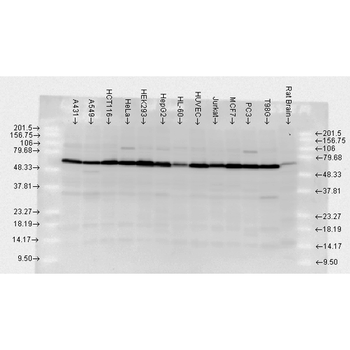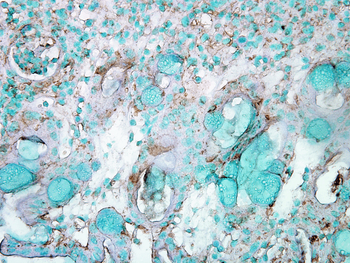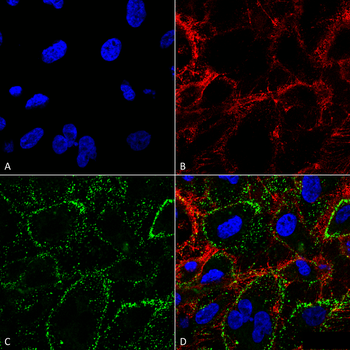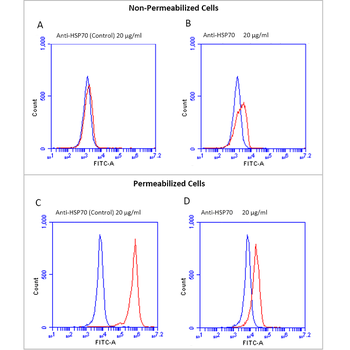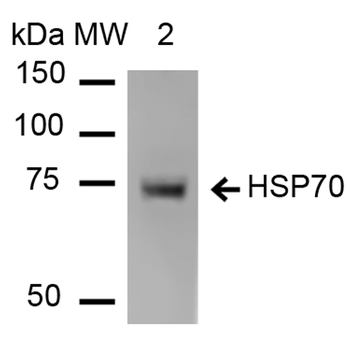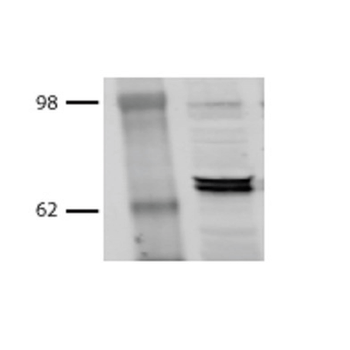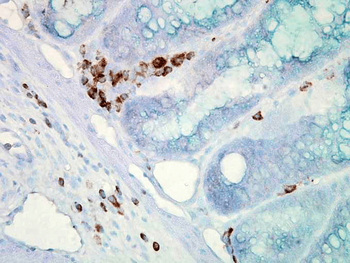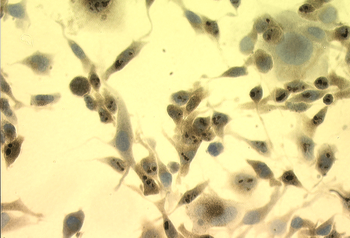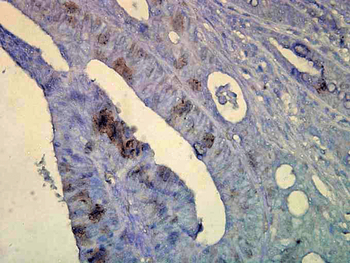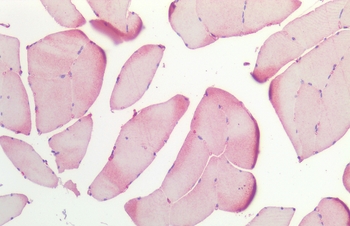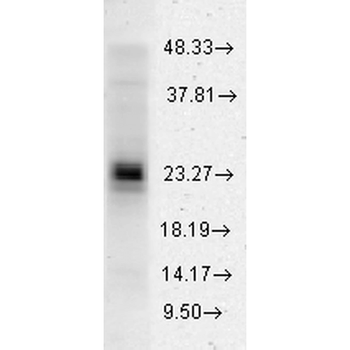You have no items in your shopping cart.
HSP70 Antibody: APC
Catalog Number: orb151946
| Catalog Number | orb151946 |
|---|---|
| Category | Antibodies |
| Description | Chicken polyclonal to Hsp70 (APC). Hsp70 genes encode abundant heat-inducible 70-kDa hsps (hsp70s). In most eukaryotes hsp70 genes exist as part of a multigene family. They are found in most cellular compartments of eukaryotes including nuclei, mitochondria, chloroplasts, the endoplasmic reticulum and the cytosol, as well as in bacteria. The genes show a high degree of conservation, having at least 5O% identity. The N-terminal two thirds of hsp70s are more conserved than the C-terminal third. Hsp70 binds ATP with high affinity and possesses a weak ATPase activity which can be stimulated by binding to unfolded proteins and synthetic peptides. When hsc70 (constitutively expressed) present in mammalian cells was truncated, ATP binding activity was found to reside in an N-terminal fragment of 44 kDa which lacked peptide binding capacity. Polypeptide binding ability therefore resided within the C-terminal half. The structure of this ATP binding domain displays multiple features of nucleotide binding proteins. All hsp70s, regardless of location, bind proteins, particularly unfolded ones. The molecular chaperones of the hsp70 family recognize and bind to nascent polypeptide chains as well as partially folded intermediates of proteins preventing their aggregation and misfolding. The binding of ATP triggers a critical conformational change leading to the release of the bound substrate protein. The universal ability of hsp70s to undergo cycles of binding to and release from hydrophobic stretches of partially unfolded proteins determines their role in a great variety of vital intracellular functions such as protein synthesis, protein folding and oligomerization and protein transport. |
| Target | HSP70 |
| Clonality | Polyclonal |
| Species/Host | Gallus |
| Isotype | IgY |
| Conjugation | APC |
| Reactivity | Human, Mouse, Rat |
| Concentration | 1 mg/ml |
| Buffer/Preservatives | 95.64mM Phosphate, 2.48mM MES and 2mM EDTA |
| Purification | PEG Purified |
| Immunogen | Full length Human HSP70 |
| UniProt ID | P0DMV9, P0DMV8 |
| MW | 70kDa |
| Tested applications | ICC, IF, IHC |
| Dilution range | WB (1:1000), ICC/IF (1:120) |
| Application notes | 1 µg/ml of SMC-178 was sufficient for detection of HSP70 in 20 µg of heat shocked HeLa cell lysate by colorimetric immunoblot analysis using Goat anti-chicken IgY:HRP as the secondary antibody. |
| Storage | Conjugated antibodies should be stored according to the product label |
| Alternative names | HSP70 1 antibody, HSP70 2 antibody, HSP70.1 antibo Read more... |
| Research Area | Cancer Biology, Cell Biology, Protein Biochemistry Read more... |
| Note | For research use only |
| Entrez | 3303 |
| NCBI | NP_005336.3 |
| Expiration Date | 12 months from date of receipt. |

Immunocytochemistry/Immunofluorescence analysis using Chicken Anti-Hsp70 Polyclonal Antibody. Tissue: Heat Shocked Cervical cancer cell line (HeLa). Species: Human. Fixation: 2% Formaldehyde for 20 min at RT. Primary Antibody: Chicken Anti-Hsp70 Polyclonal Antibody at 1:120 for 12 hours at 4°C. Secondary Antibody: R-PE Goat Anti-Chicken (yellow) at 1:200 for 2 hours at RT. Counterstain: DAPI (blue) nuclear stain at 1:40000 for 2 hours at RT. Localization: Cytoplasm. Perinuclear region of cytoplasm. Magnification: 100x. (A) DAPI (blue) nuclear stain. (B) Anti-Hsp70 Antibody. (C) Composite. Heat Shocked at 42°C for 1h.

Western blot analysis of Human Cervical cancer cell line (HeLa) lysate showing detection of HSP70 protein using Chicken Anti-HSP70 Polyclonal Antibody. Load: 15 μgprotein. Block: 1.5% BSA for 30 minutes at RT. Primary Antibody: Chicken Anti-HSP70 Polyclonal Antibody at 1:1000 for 2 hours at RT. Secondary Antibody: Goat Anti-Chicken IgY: HRP for 1 hour at RT.

Immunocytochemistry/Immunofluorescence analysis using Chicken Anti-Hsp70 Polyclonal Antibody. Tissue: Heat Shocked Cervical cancer cell line (HeLa). Species: Human. Fixation: 2% Formaldehyde for 20 min at RT. Primary Antibody: Chicken Anti-Hsp70 Polyclonal Antibody at 1:120 for 12 hours at 4°C. Secondary Antibody: FITC Goat Anti-Chicken (green) at 1:200 for 2 hours at RT. Counterstain: DAPI (blue) nuclear stain at 1:40000 for 2 hours at RT. Localization: Cytoplasm. Perinuclear region of cytoplasm. Magnification: 20x. (A) DAPI (blue) nuclear stain. (B) Anti-Hsp70 Antibody. (C) Composite. Heat Shocked at 42°C for 1h.
HSP70 Antibody: APC [orb151240]
ICC, IF, IHC
Bovine, Canine, Fish, Guinea pig, Hamster, Human, Mammal, Monkey, Mouse, Other, Plant, Porcine, Rat, Sheep
Rabbit
Polyclonal
APC
100 μgHSP70 Antibody: APC [orb54777]
ICC, IF, IHC
Bovine, Human, Mouse, Porcine, Rat
Mouse
Monoclonal
APC
100 μgHSP70/HSC70 Antibody: APC [orb146785]
ICC, IF, IHC
Bovine, Canine, Drosophila, Fish, Frog, Gallus, Guinea pig, Hamster, Human, Mouse, Other, Porcine, Rabbit, Rat, Sheep, Yeast
Mouse
Monoclonal
APC
200 μgHSP70 Antibody: APC [orb146735]
ICC, IF, IHC
Bovine, Canine, Drosophila, Fish, Gallus, Guinea pig, Hamster, Human, Monkey, Mouse, Other, Porcine, Rabbit, Rat, Sheep
Mouse
Monoclonal
APC
200 μg
HSP70 Antibody: APC (orb151946)
Participating in our Biorbyt product reviews program enables you to support fellow scientists by sharing your firsthand experience with our products.
Login to Submit a Review


